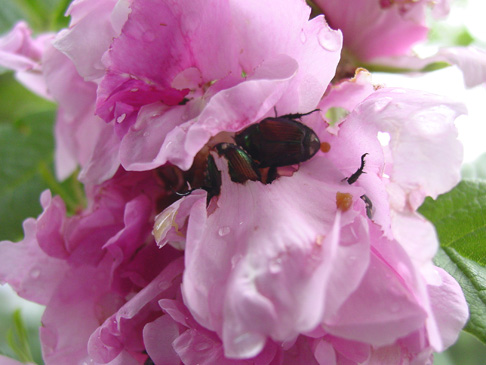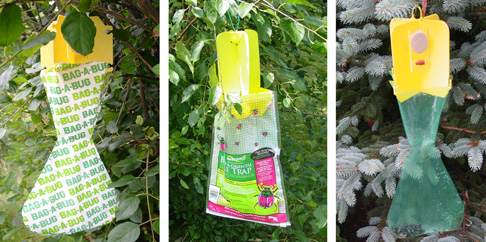We have all heard about Japanese Beetles and the damage they do to a garden. There is a lot of information about Japanese beetles available explaining how they feed on about 300 species of plants, devouring leaves, flowers, and overripe or wounded fruit. They usually feed in groups, starting at the top of a plant and working downward. The beetles are most active on warm, sunny days, and prefer plants that are in direct sunlight. A single beetle does not eat much; it is group feeding by many beetles that results in severe damage.
The females lay eggs which hatch into grubs and those grubs feed on the roots of turf grasses and vegetable seedlings, doing best in good quality turf in home lawns, golf courses, parks, and cemeteries. However, they can survive in almost any soil in which plants can live.
I did not really pay much attention to any of this information because I had a large garden and was fine with a few plants being munched. I only got upset when the beetles attacked my roses. I knew that a few shrub roses were being eaten, but when they attacked my tea rose, that was it! Since my tea rose only gets 2 or 3 flowers at a time and since they are so beautiful and fragrant, I anxiously wait for them to open and often bring them into the house. This year as surely as a bud would be ready to open, the beetles would eat holes in the flower so it looked ugly. The war was on! I decided to try Japanese beetle traps.
I currently have 3 different traps in the garden that all catch beetles. The traps work by using a pheromone as a lure to attract the beetles. Basically, the beetles think they are going to an orgy and come flying in to join their friends, only to be trapped and disposed of. I was not sure how many beetles were in my area, but I thought every beetle I did trap would not reproduce. If nothing else, I would have fewer beetles next year.
All three traps have in common a plastic top that holds the bait with the pheromone. They all have a system where the beetle goes in and cannot find its way out and they are all a bit different in how the trap looks and how easy it is to use. All of the traps say that the pheromone bait will last for the whole season.
Beetle Trap Information
- The first and least expensive is Bag-A-Bug made by Spectracide. It costs about $6.00 at Menards Home Building Center and comes with a spare bag. The bags are printed and it’s not easy to tell if you have caught any beetles. It works fine, but it would be better with a clear bag.
- The second least expensive is Rescue Japanese & Oriental Beetle Trap. It costs about $7.00 at Steins Garden Center. This one is bigger and has a very convenient zip lock closer on the bottom of the bag.
- The third and most expensive bag that I have is the Beetle Bagger made by Bonide. It costs about $8.00 at Bayside Gardens, our local nursery. This trap has the same shape as the Bag-A-Bug but the collection bag is clear so you can see if you are catching any beetles. It comes with an extra bag and you can buy more bags for this trap.
When the beetles die in any of the bags, they start to decompose and they smell rotten. Since this whole system works on smell, you must remove the dead beetles periodically from the trap for it to work properly. With the Bag-A-Bug and the Beetle Bagger, you can either replace the bag or flush out the old bag and reuse it. It is easy to change the bag, but is expensive to keep buying more bags. Flushing out the bag works, but it is very messy. The Rescue Japanese & Oriental Beetle Trap is much easier to use. When you want to clean out the trap, just slip another bag up over the closing and open the zip lock. The beetles fall out of the trap into the new bag and can be sealed up and thrown in the garbage. You can then close the original bag back up and let it continue to collect more beetles. I liked this bag the best because it is the easiest one to empty and lets face it – bugs are disgusting.
I was not aware of how many beetles were actually living in my yard, but those traps caught a scary amount since their installation. No wonder the poor roses were being decimated! I decided to keep the traps working until the beetles stop coming and my hope is that next year the roses will be able to bloom without fear of being eaten.






Get them bugs! ew!
I know, especially when they are dead and smell bad!